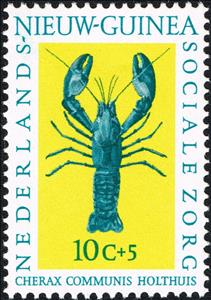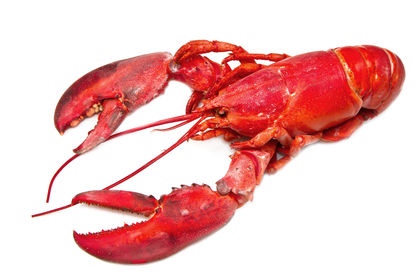Stamp: Blue Papuan Freshwater Crayfish (Cherax communis) (Netherlands New Guinea 1962)
Blue Papuan Freshwater Crayfish (Cherax communis) (Netherlands New Guinea 1962)
17 September (Netherlands New Guinea ) within release Surtax for social works organizations goes into circulation Stamp Blue Papuan Freshwater Crayfish (Cherax communis) face value 10+5 Dutch cent
| Stamp Blue Papuan Freshwater Crayfish (Cherax communis) in catalogues | |
|---|---|
| Michel: | Mi:NNG 79 |
| NVPH: | NVP:NNG 79 |
Stamp is vertical format.
Also in the issue Surtax for social works organizations:
- First Day Cover - Crayfish - MiNo. 78-81 face value 100;
- Stamp - Spotted Reef Crab (Carpilius maculatus) face value 5+5;
- Stamp - Blue Papuan Freshwater Crayfish (Cherax communis) face value 10+5;
- Stamp - Tahitian Prawn (Macrobrachium lar) face value 25+10;
- Stamp - Painted Spinny Lobster (Panulirus versicolor) face value 30+10;
Stamp Blue Papuan Freshwater Crayfish (Cherax communis) it reflects the thematic directions:
Marine life, or sea life or ocean life, refers to the plants, animals and other organisms that live in the salt water of the sea or ocean, or the brackish water of coastal estuaries. At a fundamental level, marine life helps determine the very nature of our planet. Marine organisms produce much of the oxygen we breathe. Shorelines are in part shaped and protected by marine life, and some marine organisms even help create new land. Altogether there are 230,000 documented marine species, including over 16,000 species of fish, and it has been estimated that nearly two million marine species are yet to be documented. Marine species range in size from the microscopic, including plankton and phytoplankton which can be as small as 0.02 micrometres, to huge cetaceans (whales, dolphins and porpoises) which in the case of the blue whale reach up to 33 metres (109 feet) in length, being the largest known animal.
Crustaceans are a group of arthropods that are a part of the subphylum Crustacea (/krəˈsteɪʃə/), a large, diverse group of mainly aquatic arthropods including decapods (shrimps, prawns, crabs, lobsters and crayfish), seed shrimp, branchiopods, fish lice, krill, remipedes, isopods, barnacles, copepods, opossum shrimps, amphipods and mantis shrimp. The crustacean group can be treated as a subphylum under the clade Mandibulata. It is now well accepted that the hexapods (insects and entognathans) emerged deep in the Crustacean group, with the completed group referred to as Pancrustacea. The three classes Cephalocarida, Branchiopoda and Remipedia are more closely related to the hexapods than they are to any of the other crustaceans (oligostracans and multicrustaceans)
Animals are multicellular, eukaryotic organisms of the kingdom Animalia (also called Metazoa). All animals are motile, meaning they can move spontaneously and independently, at some point in their lives. Their body plan eventually becomes fixed as they develop, although some undergo a process of metamorphosis later on in their lives. All animals are heterotrophs: they must ingest other organisms or their products for sustenance.



